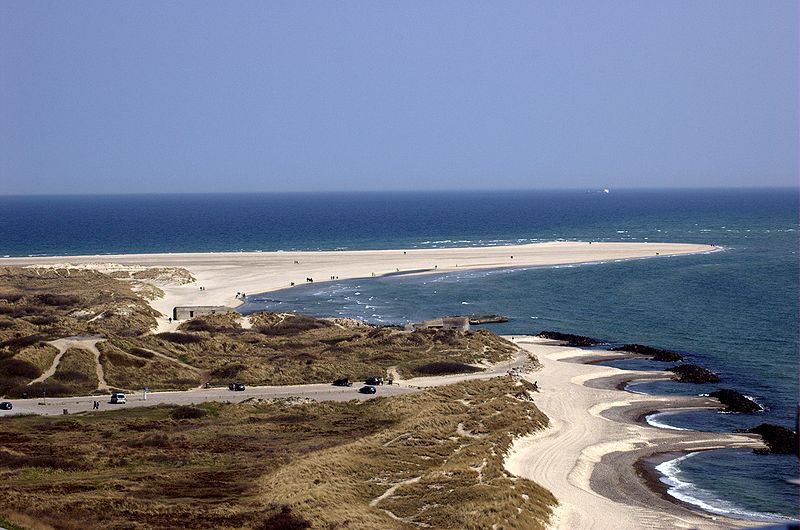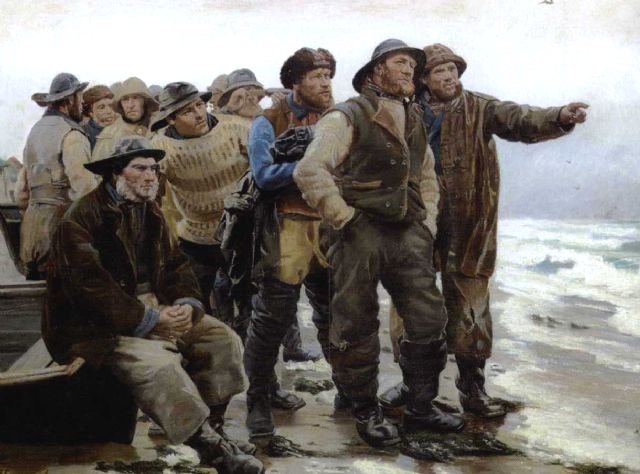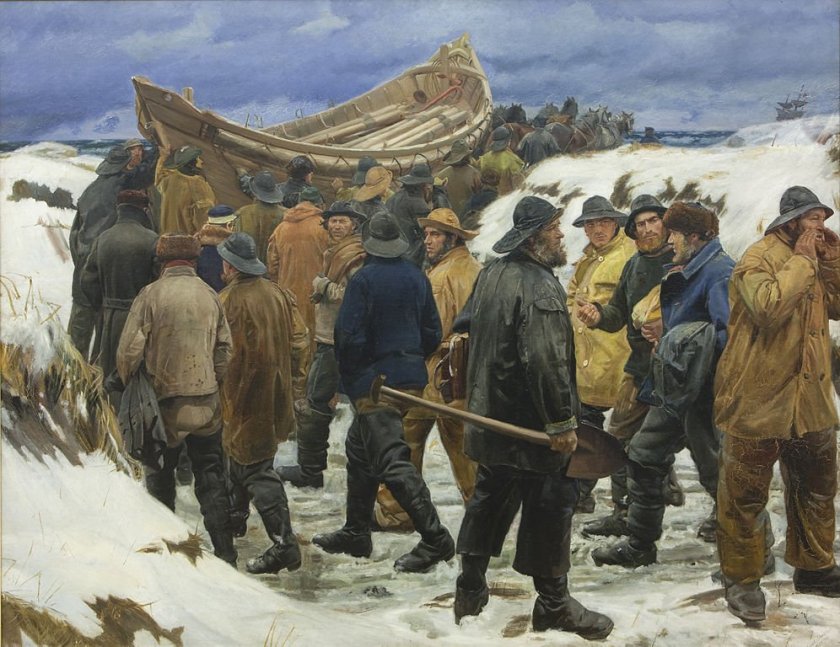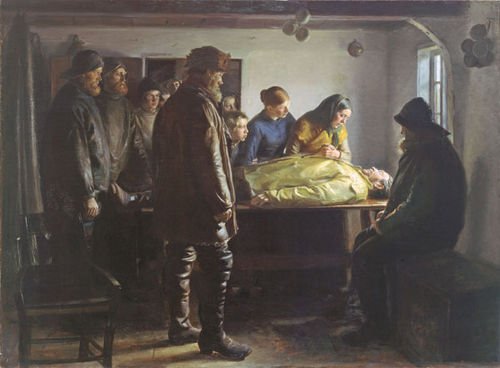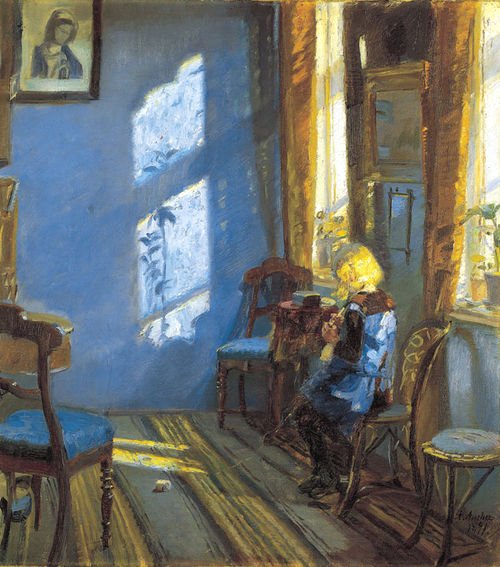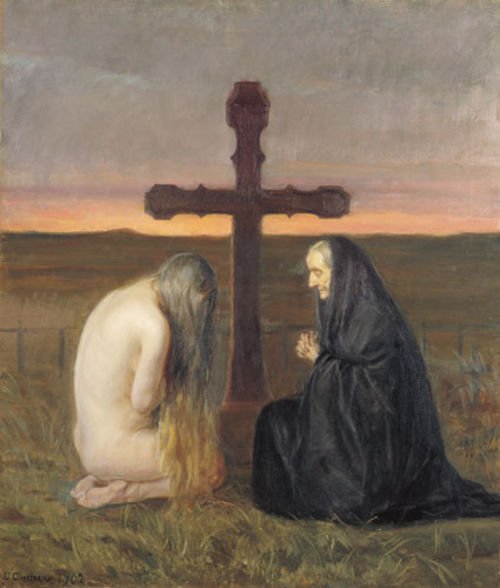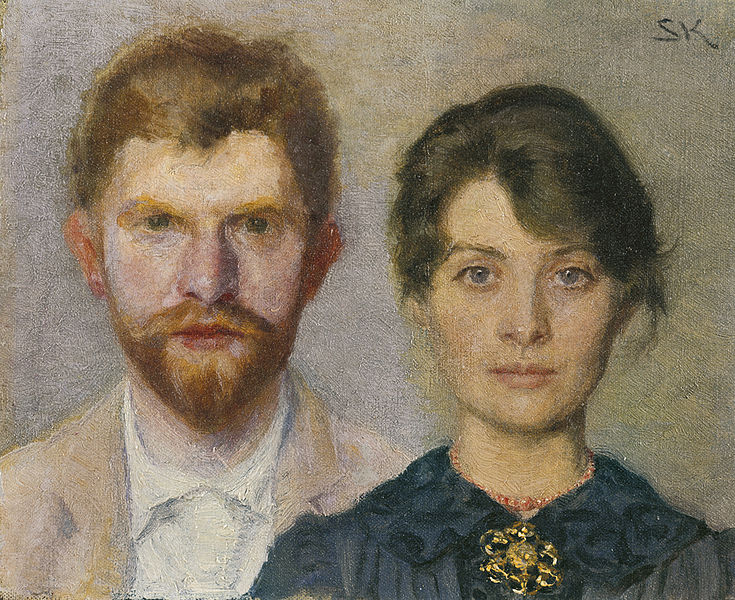
As promised in my last blog featuring the Skagen husband and wife painters, Michael and Anna Ancher, My Daily Art Display today features another married couple who resided in Skagen, Denmark and were leading lights of the Skagen artist commune. Their names were Marie and Peder Severin Krøyer.
Marie Martha Mathilde Triepcke was one of three children born to German parents in the Danish capital of Copenhagen in June 1867. She developed an early love for art and following normal schooling she decided that her future lay as an artist. For a female to train to become an artist in Denmark in those days was very difficult as women were not allowed to enrol on art courses at the Danish Royal Academy of Art and so she had to study drawing and painting at private schools. One of these art schools was the Kunstnernes Frie Studieskoler, a Copenhagen art school which had opened in 1882 as a protest against the policies and rigid dictates of the Royal Danish Academy of Fine Arts and by so doing offered an alternative to the Academy’s rigid educational program. The artist who looked after the new students was the Danish painter, Kristian Zartman. Another teacher at the art school when Maria attended was the young artist Peter Severin Krøyer. During her time at these private art establishments she received tuition in model drawing as well as some landscape, still life and portraiture. She and other artists, both male and female, were encouraged to spend time in the countryside and paint en plein air. In 1887, when she was twenty years of age she made her first trip to Skagen which had by this time become home to a flourishing artist colony.
Two years later in December 1888 at the age of twenty-one she left Denmark and travelled alone to Paris to live and further her artistic education. She studied at a number of studios including those of the French painters, Gustave Courtois and Alfred Roll. One of the studios she worked in was run by the French painter, Pierre Puvis de Chavannes and it was whilst working in his atelier she became great friends with a fellow co-worker Anna Ancher, who along with her husband Michael, featured in my last blog. Marie soon became one of the Parisian “Scandinavian artistic-set” and one of these fellow artists was Peter Severin Krøyer whom she had met before in Copenhagen. Who knows why, but suddenly the relationship between Peter and Marie intensified and they fell in love. It was a whirlwind romance because in July 1889, within six months of their Paris meeting they were married.
Peter Severin Krøyer was sixteen years older than Maria. Although he is often looked upon as a Danish painter, in fact he was born in the Norwegian town of Stavanger in July 1851. His entry into the world was not without trauma as when he was just a young baby; he was taken from his mother, Ellen, as she was considered unfit to look after her son due to being mentally ill. Peter went to live in Copenhagen where he was brought up by his maternal aunt and her husband. At the age of nine, because of his love of drawing, they arranged for him to attend art classes at a private school. A year later, he was enrolled at the Copenhagen Technical Institute. From there he attended the Royal Danish Academy of Art and in 1870, at the age of nineteen, he completed his formal studies. He, like many aspiring artists, began exhibiting his work at the Charlottenborg Palace in Copenhagen and his big breakthrough came in 1874 when the tobacco magnate Heinrich Hirschsprung bought one of his works. Hirschsprung would become one of Peter Krøyer’s patrons and funded his early European travels. This connection with Hirschsprung also had a connection with his wife-to-be Marie, as her childhood school friend was Ida Hirschsprung whose uncle was Heinrich and it was through Ida that Marie came into social contact with the Hirschsprungs and their circle of friends including Peter Krøyen.
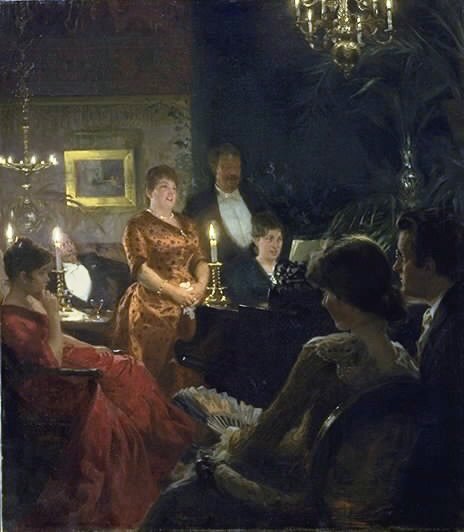
Marie Triepcke actually sat for Krøyen for his 1877 painting entitled The Duet. She is the woman in red at the left of the painting.
For the next five years Krøyer travelled extensively visiting Spain and Italy as well as spending summer months in Brittany, all the time honing his artistic skills. During the late 1870’s he would also come across the “new kids on the block” – the young French impressionists such as Monet, Sisley, Degas and Renoir. However Krøyer was more attuned to the academic painters of the time. After roaming for those five years he finally returned “home” to Denmark and in late 1881 and in the summer of 1882 he went to Skagen. He was so enamoured by this area that he bought himself a home there and it was here that he spent his summers before returning to his Copenhagen apartment in the winter months to work in his studio. Between 1882 and 1904 Krøyer was a leading figure at the newly founded Kunstnernes Frei Studieskoler where he oversaw the life drawing classes which allowed students to draw and paint images of live nudes, an art form which, at the time, was not allowed at the Royal Danish Academy of Fine Arts.
Marie Krøyer returned to Skagen with her husband Peter in 1891 and became part of the Skagen artists’ commune. Once married, her artistic output lessened for she was concentrating on interior design and floral still-life painting which could be incorporated into interior design. Another reason could have been her feeling artistically inferior in comparison to her husband, or maybe she was just overwhelmed by the burden of motherhood and looking after the house and her husband. She was quite disheartened for she was quoted as once saying:
“…I sometimes think that the whole effort is in vain, we have far too much to overcome … what significance does it really have if I paint, I shall never, never achieve anything really great … I want to believe in our cause, even if at times it may be terribly difficult…”
In 1895 she gave birth to a daughter, Vibeke and the family moved to a cottage in Skagen Vesterby where she spent time designing the interior of their home. Her life with her husband became very challenging due to a decline in his mental health and his frequent incarceration in mental homes. Her husband’s eyesight also began to gradually fail in 1900. In 1902 during a journey to Italy Marie met the Swedish composer and violinist Hugo Alfvén. She and Alfvén became lovers but Krøyer refused to give his wife a divorce. This changed in 1905 when he found out that his wife was pregnant with Alfvén’s child. Once divorced, Marie moved from Denmark and went to live with her husband and their baby daughter Margita in Tällberg, Sweden.
The couple had a new home built there, which became known as Alfvénsgården, and Maria created the interior design and furnishings of the building. The couple lived together unmarried for seven years before finally marrying in 1912 and their life together lasted twenty-four years until in 1936 they divorced. Marie retained her beloved Alfvénsgården and remained there until she died in Stockholm in May 1940, a few weeks before her 73rd birthday. On her death the house reverted to her daughter Margita and when Margita died the house went to Vibeke, Marie’s daughter from her marriage to Peter Krøyer.
Peter Severin Krøyer died in November 1909, aged 58, at which time his sight had completely failed and he was blind.

One of Krøyer’s best known works entitled Hip Hip Hurrah: An Artist’s Party on Skagen came about from his love of photography and his newly bought camera which he purchased in 1885. It was during a garden party at the house of Michael and Anna Ancher that he took the photograph which captured the celebrating guests. Delighted with the photograph, Krøyer decided to convert it into a large scale painting and wanted to bring in his models to Ancher’s garden so as to do some preliminary sketches. Michael Ancher would not go along with the plan and would not countenance the intrusion of the artist and his models into his private garden so Krøyer had the table moved to his garden and set about the work. It took him three years to complete the “stage-managed” work which in some ways resembles Renoir’s 1881 Luncheon of the Boating Party (see My Daily Art Display Aug 2nd 2011). The garden party guests are seen celebrating and raising their glasses in a toast. In the painting we have many of the leading members of the Skagen artist colony. With her back to us is Martha Johansen who was along with Maria Triepcke and Anna Ancher one of the triumvirate of great female Skagen painter. Standing on the far side of the table are the Skagen painters Viggo Johansen, the Norwegian Christian Krogh and dressed in brown Krøyer himself. The man in the white suit is Degn Brøndum, Michale Ancher’s brother in law. Next to him is Michael Ancher. On this side of the table we have the Swedish painter Oscar Björck, and the Danish painter Thorvald Niss. The lady leaning back is Helene Christensen, the local schoolteacher and wife of painter Karl Madsen and closest to us, dressed in white is Anna Ancher and her four year old daughter Helga. As in many of the Skagen paintings the feature of this work is not the people but the Skagen sunlight which streams through the trees casting shadows on the white tablecloth and shimmers on the bottles and glasses.

In contrast to Peter Krøyer’s depictions of his beautiful wife Marie, often seen strolling along the Skagen beaches, Marie’s 1889 Self Portrait is much more sombre and severe. Half her face is in shadow in this work and it could reflect her state of mind at the time she painted the work.
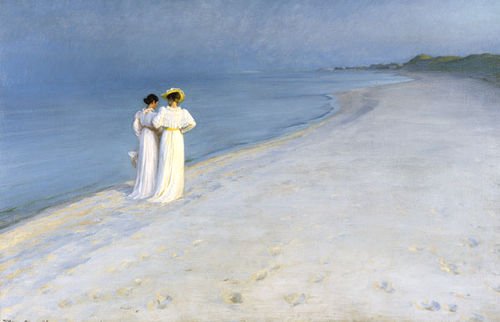
In contrast to this dark portrait we have Peter Krøyer’s painting entitled Summer Evening on Skagen’s Southern Beach which he completed in 1893. The idea for this work came to Krøyer during one of the many dinner parties he attended after which the diners would take twilight stroll along the shoreline. It is an idyllic setting and we see Peter’s wife Marie. Once again like paintings I featured by Michael Ancher and his wife the colour blue featured a lot in Krøyer’s painting during his stay in Skagen. This twilight period when day starts to lose out to night was often referred to the “blue hour” which was how they say saw the sky and sea merge into one shade of blue.
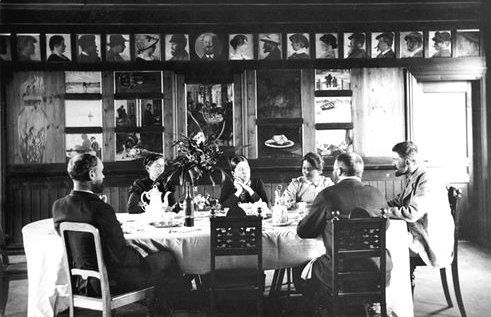
I finish this blog with a photograph of my four Skagen artists, which I have featured in my last two blogs, sitting around a dining table at the Brondum hotel once owned by Anna Ancher’s parents

